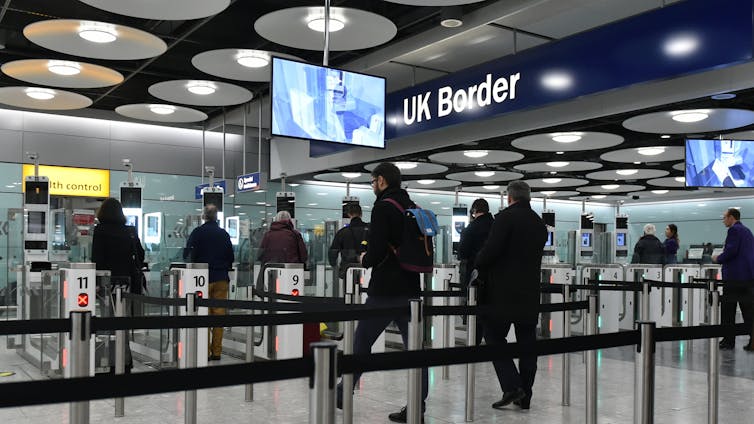The Home Office has long collected statistics on irregular migration to the UK, but it has never published them officially until now. The statistics, first published in February 2022, are on detected instances of people entering the UK without immigration permission, such as on small boats, stowing away in vehicles or containers, or using false documents.
The decision to start regularly publishing this data as part of quarterly immigration statistics is welcome. The issue is of strong public interest, yet previously, data on irregular entries appeared in the public domain mainly via freedom of information requests.
After the home secretary declared the rise in channel crossings a “major incident” in 2018, the Home Office gave some news outlets daily counts of small boat arrivals, until January 2022. But these updates lacked information about the quality of the data and its limitations, such as what counts as a “small boat” and when there may be risks of double counting. The new quarterly figures change that, and what they lack in timeliness, they make up for in clarity and accessibility.
The main finding is that the small-boat route appears to be the most common irregular route to the UK. From 2018-21, around 39,000 people arrived by crossing the channel in inflatable boats, dinghies and kayaks.
The statistics show that in 2021 substantially more people were detected travelling to the UK on small boats than by all other irregular means, including by air on false documents, and by stowing away in lorries or containers. Out of around 37,000 detected irregular entries, 78% were by small boat.
Small-boat arrivals also increased substantially in 2020 – to 8,500 from around 1,800 in 2019 – while detection on other routes fell. It is not clear why this is, but the government has stated that COVID restrictions made other routes, such as lorry or train, less viable. And the independent chief inspector of borders and immigration reported that Home Office officials believe enhanced security at French ports and the channel tunnel – to prevent stowaways on lorries and trains bound for the UK – made the small-boat route more viable.
Interpret with caution
As welcome as the new statistics are, they tell only a partial picture.
The Home Office cautions that the data is “not designed for statistical purposes and therefore should be interpreted with caution”. Notably, the Home Office says that the figures cannot be used to infer total levels of irregular migration.
This is because many irregular entries are not detected. And detection rates differ according to the method of entry. Very few people travelling in small boats will evade detection, but those entering the UK by hiding in lorries or containers could. The apparent dominance of the small-boat route in the data could result partly from undercounting of other modes of irregular entry. Another factor is the level of enforcement activity, such as how often lorries are checked, or the number of tip-offs the Home office receives.
The figures also do not include the other main way people add to the UK’s irregular migrant population: by entering lawfully on a valid visa and staying longer than the permitted period.

The statistics also do not explain why people attempt to enter the UK irregularly. Home Office testimony suggests that almost all Channel crossers claim asylum on reaching the UK – 98% did from January to September 2020. This supports an oft-cited explanation for the phenomenon: a lack of safe and legal routes to claim asylum in the UK compels refugees to take dangerous, irregular journeys.
Nor has the government published data on the outcomes of Channel migrants’ asylum applications (which we know it holds). Research suggests that a large share of these applications are likely to be successful.
The data does not explain changes in irregular migration, including the rise of the small-boat route. Some have speculated that the pandemic and more stringent controls on road travel, have had the effect of closing off lorry and air routes to the UK.
There is nothing in the data on the number of smugglers apprehended or smuggling operations disrupted, nor on the number of people prevented from departing France to reach the UK irregularly. Finally, the data does not share Channel migrants’ explanations of why they decided to cross the Channel, or why they chose to come to the UK when they could have claimed asylum in other European countries they transited through.
Why now?
It has not been explicitly made clear why the government has published these statistics now, but the announcement comes against the backdrop of the nationality and borders bill currently before parliament. A principal aim of the bill is to deter small-boat arrivals through tougher criminal sanctions on irregular entry, and giving refugees fewer rights if they entered the UK irregularly. The huge rise in the number of people detected crossing the channel in small boats lends support to the government’s argument that there is a big problem to be solved.
The bill is part of a longer-term effort to decrease the size of the UK’s irregular migrant population. The government’s “hostile environment” policy, first announced in 2012, aimed to make life for people without immigration status so difficult that they would leave the UK of their own accord. There is little evidence that the policy has worked – removals and voluntary departures of irregular migrants have fallen to record lows.
It is not clear whether penalising refugees for irregular entry will reduce their arrivals. Evidence suggests that restrictive policies have little effect on the number of asylum claims – conflict and poverty in origin countries are much bigger drivers. Also, the UN has expressed concerns that proposals in the bill violate the refugee convention. Still, it is against this backdrop of legislative restrictions that new statistics help illustrate the size of the issue.
The Migration Observatory receives funding from Trust for London and the Joseph Rowntree Charitable Trust.
This article was originally published on The Conversation. Read the original article.







